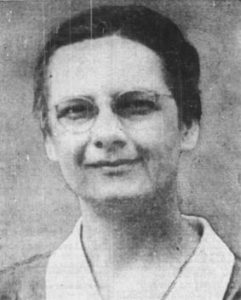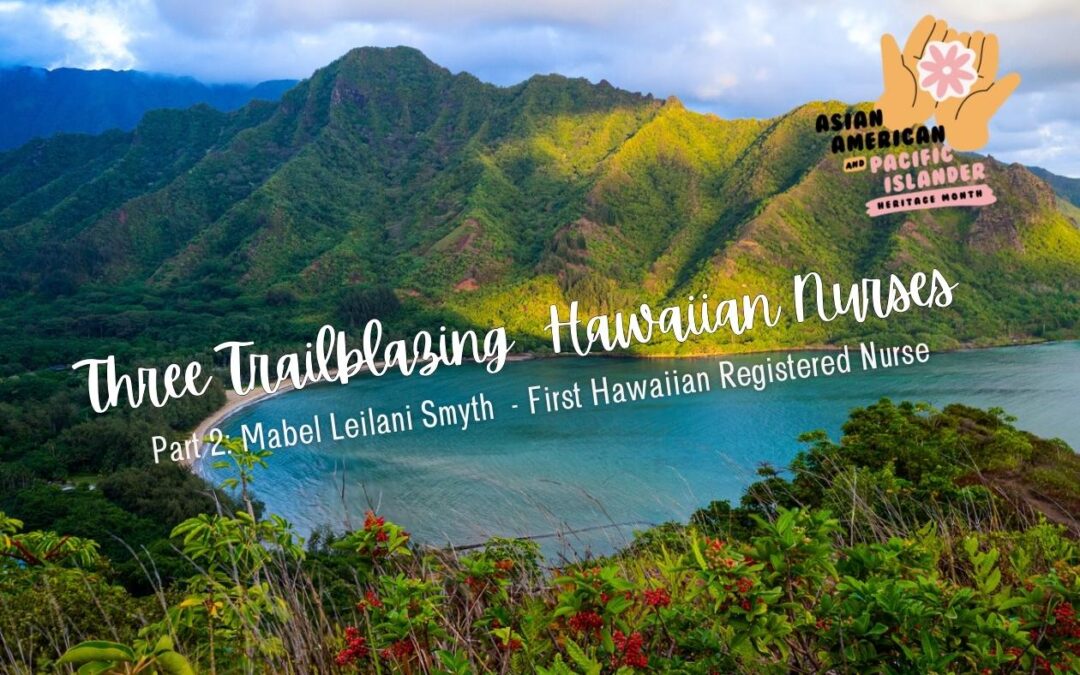Welcome to part two of Three Trailblazing Hawaiian Nurses blog series – Mabel Leilani Smyth, First Hawaiian Registered Nurse with Hawaiian ancestry, often referred to as “Hawaiʻi’s Florence Nightingale.”
In honor of Asian American and Pacific Islander Heritage Month, Minority Nurse is republishing the Three Trailblazing Hawaiian Nurses blog series from October 2022.
Hawai’i’ is one of the most multicultural and ethnically diverse places on Earth. This rich blend is reflective of its nursing history. Pioneer Registered Nurses in Hawaii include nurses of Native Hawaiian, English, Chinese, Japanese, and Filipino heritage. Their lives and work create a beautiful kaleidoscope of service that has improved the lives of residents in this tropical paradise for over 100 years. The life stories of three groundbreaking Hawaiian RNs can inspire us all.
Mabel Leilani Smyth 1892 – 1936 First Hawaiian Registered Nurse with Hawaiian Ancestry “Hawaiʻi’s Florence Nightingale”
Mabel Leilani Smyth was born in Honolulu on September 1. 1892, to Julia Goo and Halford Hamill Smyth. Like many Hawai’ians, she had an ethnically mixed lineage. Smyth’s ancestors included people from Hawai’i, England, China, and Ireland. Smyth’s older sister Eva was born visually impaired, and from a young age, Mabel was Eva’s companion and guide while her mother tended to the three younger children and her father was at sea. Caring for her sister foreshadowed a lifetime of caring for others.
Smyth spent her childhood on her mother’s Kona coffee farm in Hawaii. All the Smyth children worked hard picking and cleaning coffee beans and cultivating and pounding taro root to make poi, a national dish of Hawai’i. Julia Smyth earned additional money weaving and selling lauhala hats. The family was trilingual, speaking Hawaiian, English, and Pidgin in the home. Being fluent in three languages helped her cross racial and ethnic boundaries and gain acceptance in multiple communities. After Smyth’s father died around 1907, the family moved to the Palama neighborhood, a suburb of Honolulu on the island of Oahu. In 1910, Smyth graduated from President William McKinley High School and began working as a nanny for the Rath family.
Mabel Smyth Begins Career as a Nurse
James and Ragna Rath, Caucasian social workers, moved from Massachusetts to Hawaii in 1905 for James to direct the Palama Settlement, a multifaceted community service agency. In 1900 at least five cases of bubonic plague were reported in the Chinatown section of Honolulu. To eradicate the threat, city officials decided to burn the homes of the plague victims. Unfortunately, the fire burned out of control, destroying at least four blocks of Chinatown. As a result, thousands of recent impoverished immigrants were homeless, and many lost their jobs and businesses. The Central Union Church created the Palama Settlement (PS) in response to these dire conditions. Church officials founded and supported many programs, including visiting nurses, a pure milk station, a day camp for children with tuberculosis, an adult night school where English lessons were taught, a day care center for working mothers, and a swimming pool with hot showers. James Rath was busy overseeing these efforts, and Regna Rath worked by his side. The Raths had five children and needed at-home childcare, so they hired Mabel Smyth.
In 1912 the Raths took their five children and Smyth to Massachusetts for a sabbatical. Before the Raths returned to Honolulu, they encouraged and arranged for payment for Smyth to attend the Springfield Hospital Training School for Nurses. Upon her graduation in 1915, Smyth returned to her family in Honolulu. She spent two years as the “agent” of the Hawaiian Humane Society. The Society had a mission to relieve suffering wherever it was found – among children, animals, and even battered wives. Smyth left the Society to become the first nursing supervisor at the PS. Organizationally, the PS divided the city of Honolulu into seven districts, with a nurse assigned to each. Each nurse was responsible for providing their district school nursing, home visiting, and clinic hours. At age 26, Smyth oversaw the entire nursing program.

Mabel Leilani Smyth was the first Hawaiian Registered Nurse with Hawaiian ancestry, often referred to as “Hawaiʻi’s Florence Nightingale”
Smyth is First Hawaiian Nurse to Earn Advanced Certificate in Nursing
Smyth took a year off from the PS, from August 1921 to August 1922, to pursue graduate work in public health nursing at Simmons College in Boston. She was the first Hawaiian nurse to earn an advanced certificate in nursing. After her year of graduate studies, she continued her supervisory work at PS until 1927, when she accepted a position with the Territorial Board of Health as the first Director of the Public Nursing Service for the Territory of Hawaii. Up to that time, the Board of Health had hired nurses in either tuberculosis work or maternal child health work. Under her leadership, these programs merged and expanded to create a generalized public health nursing program covering all the islands in the Territory. Two years later, the nurses at the PS came under the auspices of the Department of Public Health Nursing to better coordinate care and reduced duplication of services.
Smyth gave many lectures to community and professional groups on the islands to increase public understanding and support for public health nursing. She successfully strove to upgrade lay midwives’ skills and standards, instituted immunization drives against diphtheria, coordinated chest x-ray screenings for TB, organized well-baby clinics across the islands, and represented Hawaii at several national public health meetings on the mainland.
In addition to her work, Smyth was a leader in professional nursing organizations. She was a charter member of the Nurse Association of the Territory of Hawaii when it was formed in 1920 and then elected president of the organization in 1925 and 1932. Smyth was also president of the City and County of Honolulu Nurses Association, a leader of the Honolulu Chapter of the American Red Cross, and a member of the Board of Registration of Nurses from 1925 to 1935. In 1926, Smyth was a small group of nurses who created a public health nursing course at the University of Hawaii to prepare nurses who wanted to practice public health nursing.
Hawaiian Florence Nightingale
Sadly, Smyth’s life was cut short at the young age of 43 after spending half her life serving others. A sewing needle had been lodged in her chest since she was a child. On March 24, 1936, she underwent an operation to remove the needle and tragically died of a post-surgical embolism that same day.
Smyth was widely mourned both in Hawaii and in the nursing community. Her obituary in the American Journal of Nursing read in part:
Endowed with charm and a dynamic personality, she had attained a high position in the ranks of Hawaiian women of achievement. Through her devotion, sympathy, keen sense of community responsibility, spirit of cooperation, and intelligently directed energy, Miss Smyth was, at the time of her untimely death, at the very height of her powers, the outstanding leader in nursing in the Territory of Hawaii.
After her death, a committee was formed to establish a memorial to the “Hawaiian Florence Nightingale.” It raised over $110,000 for the Mabel Smyth Memorial Building, with over 4,000 people contributing. The building was dedicated on January 4, 1941, with Hawaiian chants and music. It housed offices of the medical and nursing professional organization on the island, classrooms, a library, and an auditorium. The building was a fitting memorial to a nurse who did so much for her family, neighbors, and all Hawaiians.
Check back next week for part 3 of the Three Trailblazing Hawaiian Nurses blog series – Alice Ting Hong Young, Hawaii’s First Nurse Midwife.



